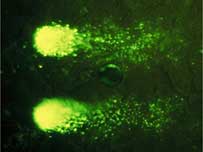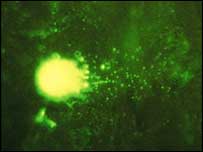![]()
Last Updated: Friday, 20 February, 2004, 15:47 GMT ![]()
![]()
Low-level magnetic fields concern
By
Dr David Whitehouse
BBC News Online science editor
![]()
|
Exposed brain cells release damaged DNA |
Exposure
to low-level magnetic fields could be harmful, say US scientists.
Rats exposed to magnetic
fields similar to those humans encounter developed damage to the DNA in their
brain cells.
Professor Henry Lai, of
Washington University, said that people should be prudent in their use of
electrical devices held close to the head.
The peer-reviewed study is
published in Environmental Health Perspectives, a journal of the US National
Institute of Environmental Sciences.
Duration can be damaging
The researchers discovered
that rats exposed to a weak magnetic field oscillating 60 times per second for
24 hours showed DNA damage. Rats exposed for 48 hours showed even more damage.
They also say that the
exposure resulted in an increase in brain cell apoptosis or "cell
suicide" - a process in which the cell self-destructs because it cannot
repair itself.
But what are the implications
for people and the magnetic fields most of us encounter in our daily lives?
|
Unexposed rats brain cells do not |
Speaking to BBC
News Online, Professor Lai said that, in his opinion, prolonged exposure to
low-level magnetic fields, such as those emitted by hair dryers, electric
blankets and razors could damage human brain cells.
"We do not use hair
dryers or electric razors for more than a few minutes each day. However, the
exposure to magnetic fields from these devices, held close to the head, is
quite high," he added.
"Our important result is
that in rats the harmful effect accumulates over time. The big question is, if
we use a hair dryer for five minutes a day, will the harmful effect accumulate
in humans? We do not know.
"But our results raise
the possibility that it might."
Professor Lai said that people
should be cautious and limit their exposure as much as possible.
In the summary of the research
paper, he and co-worker Narendra Singh said their work could "...have an
important implication on the possible health effects associated with exposure
to extremely-low frequency magnetic fields in the public and occupational
environments".
'Noteworthy' study
A spokesman for the UK's
National Radiological Protection Board (NRPB) described Professor Lai's study
as "interesting. Work of this sort is noteworthy".
"The research will need to
be replicated to see if it is a significant effect. If it led to a real health
effect we would have expected to have seen it in behavioural studies of rats
exposed to stronger magnetic fields for longer periods. So far we have not.
"What Professor Lai may
have seen is a biological effect," the spokesman said. "It remains to
be seen if that will be translated into a real health effect."
The NRPB advisory group has
already noted a weak association between the incidence of childhood leukaemia
and exposure to elevated magnetic fields.
The association is not
observed in the UK, but has been seen in the USA and Sweden.
One possible reason for this
difference is because the USA uses a 110-volt electricity system, which confers
a higher exposure to residual magnetic fields than the 240-volt system used in
the UK and on mainland Europe.
![]()

